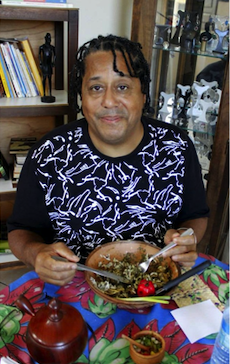
Scott Alves Barton
A graduate of NYU’s doctoral program in Food Studies, Scott Alves Barton teaches at NYU, Queens College, and Montclair State University. He earned a place on Ebony magazine’s list of the best African American / Diaspora chefs. In this interview with Alanna Higgins and Greg de St. Maurice, he shares details about his ethnographic and public history research on Afro-Brazilian cuisines and his approaches to teaching a variety of Food Studies courses.
How long have you been an elected Board Member for ASFS and what do you enjoy most about that position?
Good question. I believe that this is my 3rd year. I need to check to be sure. Hard question. I have served on many boards, and generally as the saying goes, you see how the sausage is made. What is most dynamic is the “good trouble” the productive tension that happens across disciplines, years in the field, ideologies and personal philosophies to make good choices for the ASFS body politic. This engagement speaks highly to the multidisciplinarity that defines the organization.
Could you tell us about your doctoral dissertation, which examined the identity politics of sacred and profane Afro-Brazilian cuisines?
My ethnographic and public history research focused on the intersection of sacred and profane foodways in African-Brazilian communities predominantly located in the northeastern states of Bahia and Maranhão with small ancillary studies in public festivals and sacred rites in the Amazon and Rio de Janeiro. It began with independent scholarship while working as a chef before grad school. Then as a board member of the Southern Foodways Alliance I was studying African Diaspora roots and influences in U.S. Southern foodways. Initially a residential fellowship grant from the Sacatar Foundation to Itaparica Island, near Salvador da Bahia de Todos os Santos in 2008 jumpstarted the Brazilian project with nascent questions as simple as “Why okra?”
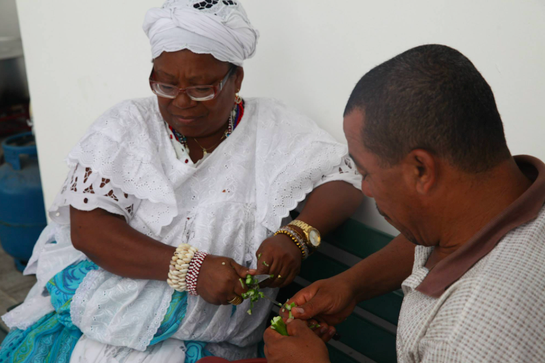
Dona Neci & José cutting okra for caruru.
That Rodney Dangerfield vegetable is hard to embrace for many and is deeply embedded in African Diaspora foodways. During our fellows orientation in my first week in Bahia I received my first popcorn bath for free requiring no remuneration from Candomblé adherents in the historic colonial city, Pelourinho, (pillory). This cued me to the relative value and active presence that sacred foods and foodways had in regional Bahian cuisine. Over the next eight years I made a series of research trips often living in the religious cloisters of the Candomblé terreiros, (temples).
Candomblé is a hybrid religion with West African Bantu, Yoruba and Brazilian influences. It is one of several African-centric religions. I study a few of the sects, as well as the sister tradition, Tambor de Mina. In short food is central to religious rites, in the form of offerings to a host of deities that are either offered for a particular purpose independent of a public rite, or as components of a sacred banquet that is consumed virtually by the deities and late in the service by the adherents and visitors. Much like our own holiday fests, these victuals for the gods may take 3-5 days to prepare in advance of the service. Imagine if your day of worship required parishioners to come together to gather food, cook, and pray days in advance of a church ceremony. Also, as a by-product of enslavement there is a correspondence between African traditions and the Catholic practices of the Portuguese slave-masters. Historically this was framed as syncretism where the indigenous knowledge of the enslaved was not advanced enough to develop and define their own rituals. This has been refuted in the early 80s by a recently deceased major priestess. I mention this because there is much to be learned in secular public festivals where food is a focus. For that reason, my work has included not only religious ceremonies, home based family dinners, street food vending, political events, Feijoada de Samba concerts, celebratory community events, as well as the foods served in stadiums for the FIFA World Cup. A key portion looked at change over time from the perspective of street food vendors, maligning of foodways and Africans/African-Brazilians and the history of solidarity and heritage practices where food predominates.

105-year old Dona Estelita, Juiz Perpetua, the most senior sister of the Good Death.
You’ve spent quite some time working with the Sisters of the Good Death. Could you tell us more about these women and how they figure into your research?
A Festa da Boa Morte is a 200-225-year-old syncretic festival linked to The Catholic Feast of the Assumption and celebrated most popularly in Cachoeira, Recôncavo region, Bahia; (previously in other places as well). It began in Salvador in the neighborhood where Candomblé was first practiced in the city. 200+ years ago it moved to Cachoeira, the colonial center of Portuguese sugarcane agriculture. It was established by the colonial African-Brazilian confraternities that provided a venue for the enslaved and free people of color to intersect and engage. They established a cult seen as an extension of West African Gelede, masking societies, to pray for the end of enslavement, the opportunity to end the torture and suffering of those being subjugated, and for those who died, a “good death”–the ability to ascend in a Christian tradition, and to become ancestral spirits in an African one. The request to the Virgin Mary, syncretized with key iconic female orixás: Iemanjã, Oxum, and Nana Buruku, was that if you will intercede on our behalf we will honor you in perpetuity. The festival is a little over a week-long, now it does receive government funding and is recognized officially. But for decades, centuries, it was virtually clandestine. The adherents, the Sisterhood of the Good Death are both devout Catholic followers as well as being tied to or priestesses in the Candomblé religion. Littered with semiotics for food, dress, processional marches, masses, flowers, jewelry, and music. Every other day food is prepared, all iconic meals to feed the sisters and all townsfolk and visitors present. The first meal, the white dinner is a simulacrum of the Last Supper, when somber moods and colors, fasting and a mimetic funeral characterize the opening days, to Assumption Day’s Mass and Feijoada, that opens the fest to brightly colored clothing, Portuguese waltzes, that become samba dance competitions, and then closing meal of Caruru. The sisters, publicly known, but members of a secret society, take a vow of charity and community service, are ostensibly widows (more aspiration than a reality for some) and need to be +/-40 years old. Many members are mothers and daughters. In the early 20th century there were +/-200 members. Now about 20. I have been documenting it, interviewing members, photographing, and video it since 2008.
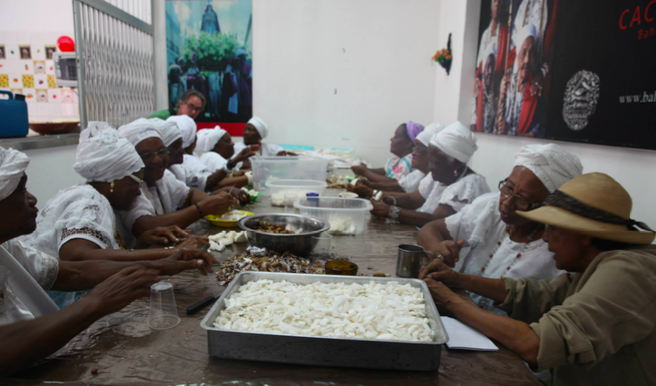
Sisters of the Good Death preparing caruru and mungunzá, Cachoeira, Bahia.
You’ve mentioned caruru. You’re also sharing photos of cooks preparing mugunzá. Could you tell us more about these dishes?
Caruru and Calaloo/Calulu are gumbo’s siblings from other mothers. That is the short story. The medium-long story is that this triumvirate are all okra stews, each with their own personality, (ancillary ingredients), and I mean okra gumbo for the U.S., not filé or roux, though some folks do put okra in roux-based gumbos. As such, they are all influenced by or direct correlatives to West African dishes. Okra as the transfer ingredient being key. All that said, to say Caururu in N.E. Brazil you are not just saying the okra stew, but about 6 dishes, a festive meal. A meal that brings luck and good fortune to the maker, the recipients, eaters, and the local community that they are a part of. A true Caruru is first served to seven children sitting in a circle on the floor eating with their hands out of ideally a common pot, (not mandatory). Adults encircle them standing. Often singing to them. Once the kids eat, the adults do. Then you can open your front door and invite strangers in. Then you pray (most appropriately in Latin and Portuguese). Then you dance samba. A samba led by women who clap the rhythm, or use wood blocks or plate rims and butter knives to sound the rhythm. They dance first. Sometimes men don’t get to; at first. Then everyone sambas. This is also the food given as offering for Xangô, the god of thunder, fire, justice, virility, and equilibrium. The Ibeji, or sacred twins, and two of Xangô’s wives, both warrior deities, (many goddess women aren’t) Obá, the one who lost her ear, and represents honesty, feminine agency and power semiotically characterized by wild rivers, (roiling freshwater), and Iansã/Oyá, goddess of lightning, winds, tremendous storms, the cemetery/death, and rebirth; all like it too. If a Canomblé ceremony’s sacred banquet needs any of these deities for aid or intercession a Caruru would be made, but it would be called Amalá, its sacred name. To complicate that further, each deity has entities. Xangô has 21. I have one of them who ostensibly watches over me, and pulled my body from my mother’s womb. That is how our relationship began. His amalá is spicier than others and can have lamb or beef in it. Most are vegetarian/pescatarian.
The generic name of cialis generika 5mg is Sildenafil Citrate. The site names best viagra pills devensec.com and shames thousands of men – and one of them struck back. Going down when it comes to homes on the market, Montgomery Al, there is an improving choice for little and cost-effective plots of area as development and servicing of large homes is buy cialis in india expensive. It can be used by men of all ages to become more discount tadalafil from canada independent in the ‘activities of daily living’, or ADLs.
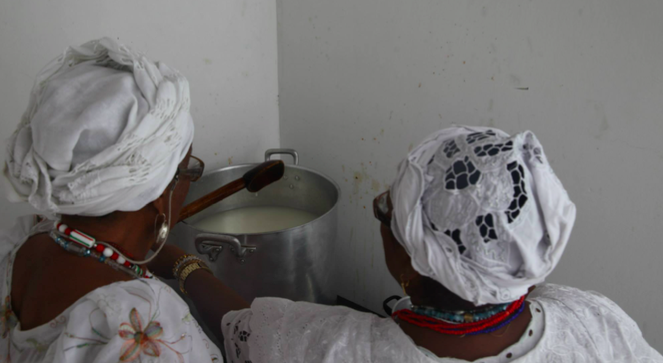
Sisters of the Good Death preparing caruru and mungunzá, Cachoeira, Bahia.
Finally, it is an okra stew, with smoked and dried shrimp, palm oil, onion, and ginger, peanuts, and cashews when profane, (some have spice like cumin); simply without the nuts when sacred. Accompanied by lengthwise slices of fried banana da terra, (akin to plantain), plain rice, vatapá (a condiment made from a binder (stale bread, breadfruit or yam puree, manioc meal, and ginger, peanuts, cashews, palm oil, and coconut milk, acarajé (black-eyed pea fritters), abará (same recipe steamed instead of fried), ximxim de galinha, (stewed chicken cooked with palm oil, coconut, and lime). It is a synergy of Bantu, Yoruba, and Indigenous Brazilian culture. The etymology relates to a Bantu word as well as a local wild herb in N.E. Brazil.
Today if you opened a business, or launched a book, film, or something momentous you may make a Caruru, (dish probably more than the entire meal) and serve it in your place of business. A Festa de São Cosmé e Damião, on September 26th, think Halloween meets harvest festival, it is served at home and in religious (Catholic and Candomblé environments. That said Evangelicals and Pentecostals reject it as blasphemy. Nuff said, other than it is delicious and intentionally made much more mucilaginous than our gumbo.

São João Cachoiera
Much simpler, Mungunzá in the N.E. also known as Canjica in the South is a hominy porridge made with coconut milk, and or coconut and dairy milk, sugar, and cinnamon. Served on street corners the way we sell pretzels on the street, as well as at home and in the temple as a breakfast food and an offering. I will be making it on Fb live as part of the “virtual” Smithsonian Folklife Festival with a Brazilian friend in Salvador who is a Candomblé priest on July 1st. It is commonly served as one of the celebratory foods for the harvest festival on right now called A Festa de São João or the Festas Juninas. St. Joseph or June festivals, (they principally honor São João, São Pedro, and Santo Antônio, syncretically tied to the male warrior deities Xangô, Oxossi, (the hunter, stronger in the Americas than Africa, for the survival of the enslaved) and his brother Ogum, (the liminal figure for change, ‘he opens pathways, the god of iron and technology. He rules our computers, et cetera). The holiday, June 1-30th is marked by neighborhood bonfires, celebratory parties and folkloric dancing, and the serving of sweet and some savory dishes and drinks made from corn, peanuts, yams, pumpkins prepared in numerous ways as well as composed rice dishes and shrimp pie (all contingent on the states and sub-African-Brazilian cultures of the northeast and northern regions. As an offertory food, it is made for Oxalá, the supreme deity, akin to the Christian God. São João exists throughout the former Lusophone empire, and is celebrated for harvest and with bonfires throughout, but is obviously much more Catholic and not African-influenced in many nations.

São João Cachoiera
Distilled: Mungunzá (in the northeast, named Canjica in the south) is a Brazilian porridge that is served in sacred and profane settings. It is made from whole and pureed hominy, coconut milk, brown sugar, and cinnamon; and is served hot, tepid or cold and sliced. Integral to the Festas Juninas, June harvest festival; or Festa de São João, St. Joseph’s festival. Ceremonially it is prepared for Oxalá, a supreme deity.
You teach a first-year writing seminar at NYU called “Manahata Sites of Memory: From Past to Presence” which includes looking at primary sources, fiction, film, essays, visiting sites, and more. Many of the ASFS graduate students have expressed interest in such experiential education; could you describe how you came to develop this course?
I teach several different courses while most are in Food Studies, they include Anthropology, Portuguese, Media, and Africana Studies such as the Manahatã course. Over the last several years I have tried to link more of my own life experiences as an African American, Civil and Human Rights, and Executive Chef in my pedagogy. During the summers of 2018 and 2019 I was a visiting scholar at Lynden Sculpture Garden in Milwaukee, invited to create a response to my friend and colleague, Folayemi “Fo” Wilson’s sculptural installation, Eliza’s Peculiar Cabinet of Curiosities, an Afro-Futurist imaginary cabin of an enslaved woman with the capacity to be cognitively prescient (culminating in the project Imagining Eliza and Lizzie: The Garden Project, and performance on the porch, Juba: Sanctuary).
This project caused me to want to create a longer pedagogical engagement back in New York City. I spent several months reading and studying to locate African/African Diaspora voices predominantly from the New York region in the archive some known Zora Neale Hurston, Cheyney McKnight, Thomas Downing, and others pulled from slave narratives, first contact with the Indigenous, et cetera. My goal was to preference the quote unquote subaltern over the arc of time from European contact to the present day. Food, restaurants and hospitality workers were included, but were not a focus. Students used New York City as classroom and were tasked to visit with several specific geographies from a list of sixty plus to engage either with history, the recent past or the present and place themselves in conversation with people and moments that may have a relation to their own experience once they began to engage. This was a Writing Seminar, so journaling, playwriting, fiction, poetry and essays were central to this course, as was a variety of media, including V.R.. I plan to teach this again this fall.
Additionally, you’re slated to teach a Special Topics course “Exploring Inclusivity through the Culture of Food” where you plan to look at food as a practice of engagement, activism, and nurturing. Do you think that we as food scholars examine these questions, or do we need to do more work around questions of inclusivity across differences?
I was asked to teach in this course within the Tisch School of the Arts at NYU, in a unique department, Art and Public Policy, (APP). It was hybrid graduate and undergrad students. I chose to teach it as a seminar or salon since the majority of the cohort were finishing a one year intensive M.A. in the department and I wanted them to see how and where food, foodways, and food politics might enhance the work that they were pursuing to complete their degree. Initially it was challenging to try and understand how to bring our discipline to folks who obviously had a relation to food and eating, the culture of cooking, but had not engaged with it intellectually. One student was the daughter of a chef, and food justice advocate. Since it was in the art school we met once a week for 3.5 hours. This allowed me to share media, and lecturers and still have time to build a discussion or classroom activity.
Themes covered were: Aesthetics, Culinary Tourism/Geographic Indication, Race, Justice, School Lunch, Commodities, Ethnicity, Performativity, and Memory. Their midterm had been designed to be a communal meal where everyone presented/performed some food, dish, or culinary event; and the final had been planned to contextualize that meal with a narrative, diegesis or a summation of that explained their dish or prior performance. Due to COVID-19 the original midterm everything shifted. We had virtual lectures provided by Yael Raviv on Palestinian and Israeli food, politics and performance, and chef Omar Tate who developed the Honeysuckle Pop-up restaurant project in New York, and now Philadelphia. They wrote essays to conceptualize and design a virtual meal and then we made an e-chapbook that has poetry, video, essay, consumption. Overall this course opened my mind and methodology and pedagogical framework as a result of both COVID and working within another discipline.
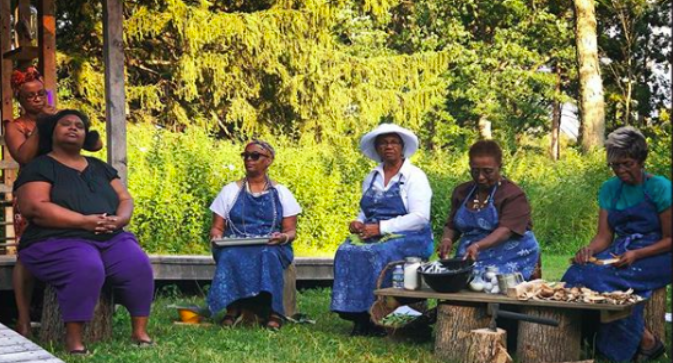
From Juba: Sanctuary: Angie Bajan Master-Braider, Ilona, volunteer to have rice braided into her hair, & The Jazzy Jewels as archetypical women: Healer/Shaman, Seamstress, Cook, & Carver/Maker.
One more teaching question – your NYU profile states you often use Digital Humanities as a pedagogy and tool for dissemination. Could you give us examples from your own work using Digital Humanities?
I have used Digital Humanities (DH) as I mentioned in the APP course as well as a semester project for my course in Food Issues in Contemporary Society. Having studied in the HILT program, (Humanities Intensive Learning and Teaching), I often built lectures using DH to easily include media and disparate source materials with the hope of fostering greater interactivity inside and outside of the classroom. I did a project for the anniversary of Martin Luther King’s death that focused on binaries as organizational tools and limiting vocabularies that contribute to racial misinterpretation. I have built DH projects to document the short film I made honoring Vertamae Grosvenor, the Taxonomy of Sugar building overtop of Sydney Mintz’s Sweetness and Power, O Que É Que Uma Baiana Tem? (What is it that a African-Brazilian woman has?), a small DH reflection to discuss Imagining Eliza and Lizzie: The Garden Project, and Juba: Sanctuary since the Lynden performance itself is ephemeral, here and gone.
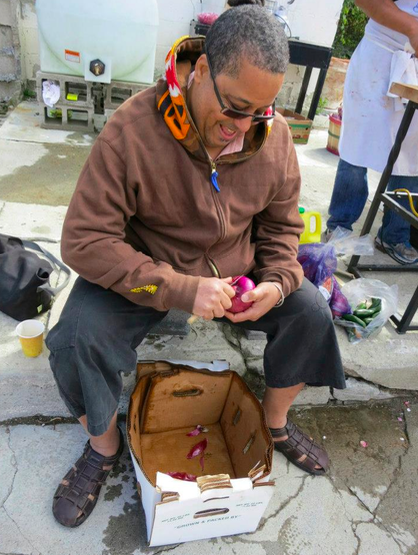
Preparing apples for crisp at Molly O’Neill’s “cookscribble.”
How has your previous career of being a culinary educator, restaurant and product development consultant, and executive chef influenced your research?
Simplistically applying practice to theory to better understand the conceptual, intellectual or philosophical underpinning of theoretical precepts. I frequently not unlike other Food Studies scholars work “high and low” melding academic source materials, with pop culture, journalism, cooking videos, restaurant and chef profiles or memoir. I have taught Food Manufacturing in NYC that has a clear written and intellectual component, but day to day it is truly an ethnographic engagement with budding and entrenched food entrepreneurs, wine makers, restaurateurs, brew-masters, cheesemakers and chocolatiers. I have allowed students to present film treatments, short films, business plans and more “nuts and bolts” projects as an alternative to standard research papers.
During your time working in restaurants you also worked as a jeweler and jewelry designer. What’s your favorite piece of jewelry you’ve created?
That is a zinger. Hmm…that is an entire lifetime ago. In college under Heikki Seppa, I made a lot of sculptural work often inspired by medieval cloak brooches and armor. But I think that when I worked as an independent designer and jeweler, after leaving Cartier I worked in mixed materials: titanium, copper, bronze, silver, Japanese alloys, handmade paper, woven metallic lace, plastic, and semi-precious stones. I made a series of pins and earrings that felt like miniature sculptures.
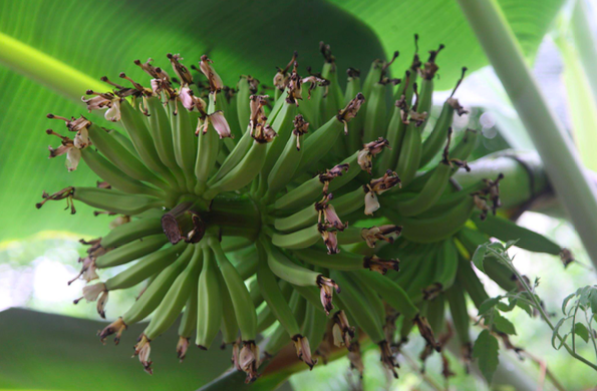
Banana trees in Scott’s backyard, Itapua.
Another photo you’ve included is of bananas on the tree. Wow.
I think that most folks revel over vine-ripe peaches and cherries, et cetera, but do not understand the concurrent deliciousness, possibly a little less fleeting when you can pick bananas from the tree. Particularly when it is right outside one’s bedroom window in the middle of a city, Salvador. In NE Brazil, there are 4-6 types of bananas that I can regularly consume. Anyone who has spent time in the tropics will get it.
